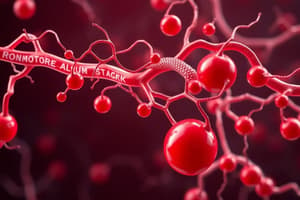Podcast
Questions and Answers
What is the purpose of renal clearance measurement?
What is the purpose of renal clearance measurement?
- To assess the overall health of the kidney tissues
- To determine the volume of plasma cleared of a substance per minute (correct)
- To measure blood pressure in the renal arteries
- To quantify the amount of waste in the kidneys
Which substance indicates active secretion if its clearance is above 125 ml/min?
Which substance indicates active secretion if its clearance is above 125 ml/min?
- Electrolytes
- Creatinine (correct)
- Inulin
- Glucose
What are the four groups of kidney function tests?
What are the four groups of kidney function tests?
- Filtration, absorption, secretion, excretion
- Glomerular, tubular, blood analysis, urine analysis (correct)
- Acid-base balance, electrolytes, volume, metabolic
- Ultrasound, CT scan, MRI, biopsy
How is the Glomerular Filtration Rate (GFR) commonly estimated?
How is the Glomerular Filtration Rate (GFR) commonly estimated?
What happens to glucose in the renal system?
What happens to glucose in the renal system?
Which kidney function involves the preparation of an ultra filtrate?
Which kidney function involves the preparation of an ultra filtrate?
What is a significant factor determining renal homeostasis?
What is a significant factor determining renal homeostasis?
What does a urine analysis typically evaluate?
What does a urine analysis typically evaluate?
What is the main reason GFR is considered the best measure of glomerular function?
What is the main reason GFR is considered the best measure of glomerular function?
Which condition occurs when GFR decreases by 30% from normal levels?
Which condition occurs when GFR decreases by 30% from normal levels?
What factor does NOT influence creatinine clearance (CC)?
What factor does NOT influence creatinine clearance (CC)?
How is creatinine clearance (CC) defined mathematically?
How is creatinine clearance (CC) defined mathematically?
Which of the following is true regarding the estimated Glomerular Filtration Rate (eGFR)?
Which of the following is true regarding the estimated Glomerular Filtration Rate (eGFR)?
What is the primary product of gluconeogenesis in the renal cortex?
What is the primary product of gluconeogenesis in the renal cortex?
Which substrate is predominantly utilized for gluconeogenesis in the liver?
Which substrate is predominantly utilized for gluconeogenesis in the liver?
What effect does reduced intracellular fluid pH have on renal gluconeogenesis?
What effect does reduced intracellular fluid pH have on renal gluconeogenesis?
Which of the following is a major source of ATP production in the renal proximal convoluted tubule (PCT)?
Which of the following is a major source of ATP production in the renal proximal convoluted tubule (PCT)?
What happens to free fatty acids (FFAs) delivered to the kidney in excess of its energy needs?
What happens to free fatty acids (FFAs) delivered to the kidney in excess of its energy needs?
Which of the following substrates is utilized for gluconeogenesis specifically in the renal cortex?
Which of the following substrates is utilized for gluconeogenesis specifically in the renal cortex?
What is one of the differences in the regulation of gluconeogenesis between the liver and renal cortex?
What is one of the differences in the regulation of gluconeogenesis between the liver and renal cortex?
Which of the following statements is true regarding glycogen metabolism in the kidney?
Which of the following statements is true regarding glycogen metabolism in the kidney?
What is the primary site of ammoniagenesis in the kidneys?
What is the primary site of ammoniagenesis in the kidneys?
Which enzyme is responsible for breaking down glutamine into glutamate and NH3?
Which enzyme is responsible for breaking down glutamine into glutamate and NH3?
What is the mechanism by which ammonium ions are secreted into the tubular lumen?
What is the mechanism by which ammonium ions are secreted into the tubular lumen?
How does the kidney primarily eliminate acidity?
How does the kidney primarily eliminate acidity?
What characterizes metabolic acidosis?
What characterizes metabolic acidosis?
Which of the following describes respiratory alkalosis?
Which of the following describes respiratory alkalosis?
What is a consequence of the kidneys' inability to form bicarbonate?
What is a consequence of the kidneys' inability to form bicarbonate?
Which of the following statements about acidosis and alkalosis is true?
Which of the following statements about acidosis and alkalosis is true?
What is the primary function of erythropoietin?
What is the primary function of erythropoietin?
What is angiotensinogen and where is it synthesized?
What is angiotensinogen and where is it synthesized?
How does angiotensin II primarily affect the adrenal cortex?
How does angiotensin II primarily affect the adrenal cortex?
What role does renin play in the RAAS system?
What role does renin play in the RAAS system?
What is the molecular weight of erythropoietin?
What is the molecular weight of erythropoietin?
What is the primary action of angiotensin-converting enzyme (ACE)?
What is the primary action of angiotensin-converting enzyme (ACE)?
Which of the following statements about angiotensin III is false?
Which of the following statements about angiotensin III is false?
What effect does aldosterone have on potassium levels in the body?
What effect does aldosterone have on potassium levels in the body?
Which statement correctly describes angiotensin IV?
Which statement correctly describes angiotensin IV?
What triggers the release of renin from the juxtaglomerular apparatus?
What triggers the release of renin from the juxtaglomerular apparatus?
Study Notes
Metabolic Functions
- Carbohydrate, lipid, and protein metabolism are essential for producing energy and maintaining homeostasis.
Erythropoietin Synthesis
- Erythropoietin (EPO) is a peptide hormone with a molecular weight of 30.4 kDa, consisting of 165 amino acids.
- Also known as haematopoietin or haemopoietin, EPO is primarily secreted by the kidneys in response to cellular hypoxia.
- EPO stimulates erythropoiesis, promoting hemoglobin and red blood cell synthesis in the bone marrow.
RAAS System
- The Renin-Angiotensin-Aldosterone System (RAAS) regulates blood pressure and fluid balance through hormonal actions.
- It stimulates the production of angiotensin II and aldosterone, crucial for maintaining electrolyte balance.
Angiotensinogen (AGT)
- AGT is a liver-synthesized α2-globulin with 485 amino acids, including a 33 amino-acid signal peptide.
- It serves as the precursor for angiotensin and belongs to the serpin family (serpin A8).
- The first 12 amino acids of AGT are critical for its activity.
Renin
- Renin is a 340 amino acid proteolytic enzyme (37 kDa) released from the juxtaglomerular apparatus of the kidney in response to decreased renal perfusion pressure.
- It cleaves AGT to form angiotensin I (Ang I).
Angiotensin-Converting Enzyme (ACE)
- ACE converts Ang I to angiotensin II (Ang II) by removing two C-terminal residues, primarily occurring in the lungs.
- ACE is also present in endothelial cells, kidney epithelial cells, and the brain.
Angiotensin II
- Ang II is an octapeptide and a potent vasoconstrictor, acting on AT1R and AT2R receptors.
- It promotes aldosterone release, influencing sodium and potassium homeostasis.
- Ang II stimulates ADH secretion, further enhancing water retention.
- Metabolized to Ang III and angiotensin 1-7 in tissues, which can catabolize into smaller peptides.
Angiotensin III
- Ang III is formed from Ang II by aminopeptidase A (APA) and binds to AT1R and AT2R.
- It plays a significant role in central regulation of hypertension and vasopressin release.
Angiotensin IV
- Formed from Ang III by aminopeptidase N (APN), Ang IV binds to AT4R and AT2R while inhibiting AT1R.
Renal Gluconeogenesis
- The renal cortex has gluconeogenic enzymes (including glucose-6-phosphatase), facilitating glucose production from pyruvate, lactate, and other substrates.
- Renal gluconeogenesis primarily serves to regulate blood pH, especially during acidosis.
Lipid Metabolism
- Kidney's PCT utilizes mitochondrial β-oxidation of free fatty acids (FFA) for ATP production, significantly contributing to renal oxygen consumption.
- Excess circulating FFAs can be stored as triglycerides in lipid droplets.
Ammoniagenesis
- Occurs in the proximal convoluted tubule, generating ammonium from glutamine via glutaminase and glutamate dehydrogenase.
- Ammonium ions help buffer urinary pH and are excreted in exchange for sodium ions.
Acid-Base Balance
- Disturbances in acid-base balance lead to acidosis (pH < 7.4) or alkalosis (pH > 7.4).
- Metabolic and respiratory acidosis/alkalosis arise from different physiological causes.
Kidney Function Summary
- Kidneys filter, reabsorb, and synthesize key substances like glucose and hormones, including erythropoietin and renin.
- They play a critical role in maintaining extracellular volume, acid-base status, blood pressure, and electrolyte balance.
Renal Function Biomarkers
- Kidney function tests are crucial for evaluating renal performance, categorized into glomerular function tests, tubular function tests, blood analysis, and urine analysis.
Glomerular Filtration Rate (GFR)
- GFR assesses glomerular function and is commonly estimated through inulin clearance.
- Normal GFR is vital for renal health, with decreases indicating renal insufficiency.
Creatinine Clearance (CC) Test
- Creatinine clearance estimates the volume of plasma cleared of creatinine per minute, reflecting kidney efficiency.
- Normal CC ranges from 120-145 ml/min, influenced by muscle mass and other factors.
Diagnostic Importance
- Monitoring GFR and CC values can help identify and manage renal conditions, guiding treatment and assessment of kidney health.
Studying That Suits You
Use AI to generate personalized quizzes and flashcards to suit your learning preferences.
Related Documents
Description
This quiz covers essential metabolic functions, specifically focusing on carbohydrate, lipid, and protein metabolism. It also explores erythropoietin synthesis, its role in red blood cell production, and details on the RAAS system. Test your knowledge on these vital biological processes!




